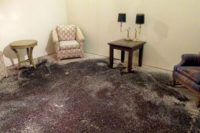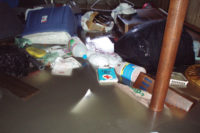Getting Paid for a Commerical Sewage Loss
A continuing conversation on getting paid, working with mortgage companies, and insurance dilemmas.

In December, you read about six factors to consider to be sure you get paid for commercial category 3 water jobs. It was part of an ongoing conversation about a shift in coverage on these claims. While most insurance policies exclude coverage for cat 3 water, for decades they were paid out anyway by adjusters. Now, things are changing, and getting category 3 water jobs paid for is not so easy.
For unknown reasons, claims adjusters must have read the 12-year-old fungi and bacteria sublimits on property policies in 2016 and started pulling the trigger on denying claims under the sublimits of coverage.
The relatively sudden change in claims handling protocols on property insurance is evidenced in the 2016 loss experience of Environmental Impairment Liability insurance policies sold to commercial property owners. A mold claim never reaches an EIL policy if the property policy is paying for the loss.

Almost all mold-related EIL claims in 2016 came in from commercial buildings like hotels, condos, schools and shopping malls.
In 2016, there were more mold losses paid on Environmental Impairment Liability (EIL) type insurance policies than from all other sources of contamination losses paid for under that type of insurance. EIL policies were designed for use by industrial firms and waste disposal companies. Today, there are more mold claims under EIL policies than the claims arising from industrial spills, leaking landfills and pipelines.
Almost all mold-related EIL claims in 2016 came in from commercial buildings like hotels, condos, schools and shopping malls. These firms are not traditional buyers of EIL-type insurance policies and almost all of these buildings do not have this coverage in place today. Problem!
Here is why mold evolving as the #1 source of claims under EIL policies is such an important development to a restoration contractor wanting to get paid for commercial work:
- Less than 1% of all commercial buildings are insured under a EIL type insurance policy today;
- 99% of building owners are needlessly uninsured for mold/bacteria related damages today;
- Only claims that are not covered in the property and liability policies of the property owner make it to the EIL coverage for payment;
- The amount of mold work country-wide in 2016 was stable to the levels of 2014 and 2015;
- The number of EIL policies insuring commercial buildings only grew 8% over those three years;
- Which means for EIL policies to get a surge in mold claims, claims adjusters must have started to deny more mold related losses under the standard property policies in 2016 and;
- With only a 1% market penetration for the EIL insurance product line in commercial construction in 2016, there must be a lot of property losses where the property owners are not getting the claims settlements they were expecting from the property insurance company;
All this translates to more bad debts for restorers.

The solution to the mold/bacteria coverage gap is a specially designed EIL type insurance policy that insures losses form “pollutants” including all sorts of microbial matter.
Mold-related claims being denied coverage will financially challenge many property owners. A large uninsured property loss could leave a restorer in a lurch financially if the restoration work has been completed before the stakeholders in the building figure out that the insurance coverage is only going to pay a $10,000 sublimit of coverage for a loss that involves a speck of mold.
To make sure a property owner has the money to pay for water restoration work in a world of enlightened claims adjusters, it will become increasing important for commercial property to be insured under and specially modified Environmental Impairment Liability (EIL) insurance policy.
Today, less than one out of 100 commercial properties actually have this type of insurance in place. Which means today less than one out of 100 property owners will have the insurance needed to pay more than $10,000 for a loss involving a speck of mold or bacteria in any sequence to the loss event.
Of course, limiting the coverage for the entire loss to only $10,000 assumes the insurance claims adjuster is paying attention to the exact words in the exclusions for fungi or bacteria in almost all types of commercial insurance policies. On small losses the adjusters tend to ignore the sublimits or errantly apply them to only the part of the loss involving the direct remediation of mold or bacteria. The problem is the bigger the loss, the ones you would never want an uncollectable bill from, the more claims supervisors there are looking at it. The smart supervisors realize every time they pay a mold or category 3 water loss like the sublimits do not exist, they undermine the insurance company’s ability to use the flood exclusion which is built under the same insurance design. As a result, the larger the loss the less likely the property insurance company is going to pay for it.
The solution to the mold/bacteria coverage gap is a specially designed EIL type insurance policy that insures losses form “pollutants” including all sorts of microbial matter.
These new generation EIL-type policies will be marketed under various brand names, we have one that took eight years in research and development to create. We brand named our EIL policy for commercial property the ARMR-HPR insurance program. HPR stands of Highly Protected Risk. The HPR part of the insurance product is we will only insure a property at the very favorable rates if all of the insured locations covered under the policy have an Emergency Response Plan in place with an approved restoration firm, and that each building has been walked through by the restoration firm.
With a ERP in place from an approved restorer we can insure commercial buildings for about half the cost of an EIL type policy sold without an ERP plan. Typically, the premium for the ARMR-HPR product is less than 15% of the current property insurance premiums, which puts the needed coverage to close the gaps in insurance coverage created by mold and bacteria exclusions and sub-limits on property and liability insurance policies within the reach of most property owners and management firms.
Connecting the dots on all of this it is looking like the mold claims in EIL type policies can only be explained by changes in claims payment practices under traditional property insurance policies. Since 2005, property insurance policies have had sub-limits for mold and sometimes bacteria related damages as little as $10,000. As many property insurance policies are written, the most a claims adjuster should pay for the entire job involving cleaning a speck of mold in any sequence to the project is the amount of the sub-limit. To have adequate coverage for mold/bacteria related work in commercial buildings, property owners and managers need to either dramatically increase the mold/bacteria sub limits from $10,000 to a far larger amount or procure a separate specially designed EIL type insurance policy.

The best way to get paid for mold and bacteria contamination work is to have an insured building. More than 99% of commercial building are underinsured today for mold or bacteria related losses.
Restorers with EIL policies can help property owners procure this needed coverage for mold and bacteria related losses by providing Emergency Response Plans to property owners and managers. By encouraging property owner and managers to get insured for what a water intrusion event involving mold or bacteria is likely to cost is the best way to assure you will be paid for the work you do on any loss involving a speck of any form of mold and sometimes bacteria. The best way to get paid for mold and bacteria contamination work is to have an insured building. More than 99% of commercial building are underinsured today for mold or bacteria related losses.
We are building out the network of contractors to provide the Emergency Response Plans in support of the new ARMR.HPR product line for commercial buildings to be released on January 4th.
Looking for a reprint of this article?
From high-res PDFs to custom plaques, order your copy today!






